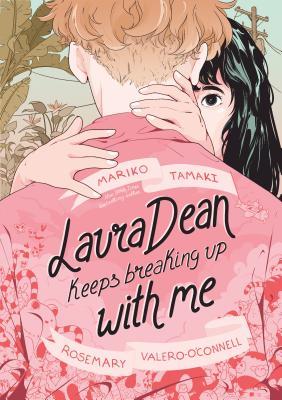Review: Mariko Tamaki’s Laura Dean Keeps Breaking Up with Me
Emma Shacochis // Blog Assistant
Frederica “Freddy” Riley feels like she’s lucky. Her girlfriend, Laura Dean, is, on paper, the girl of her dreams: confident, popular, and beautiful. The only issue is that, almost every time a holiday rolls around, Laura finds a reason for the two of them to break up.

Frustrated by her devotion to Laura’s lies and infidelities, Freddy seeks help in the from emails to Anna Vice, an advice columnist; her group of best friends, none of whom are particularly keen on Laura themselves; and the Seek-Her, a fortune teller whose verdict on the situation is that Freddy must be the one to break up with Laura Dean. As she’s drawn in again and again by Laura’s charm, Freddy begins to feel more and more distant from her loved ones, her best friend Doodle (whose struggles she’s oblivious to), and her sense of self.
As a graphic novel, Laura Dean Keeps Breaking Up with Me features two elements that make the medium so enamoring: naturalistic dialogue, and gorgeous illustrations. Mariko Tamaki has created a cast of characters that you’re allowed to see both sides of: Laura Dean’s undeniable charisma and her abrupt dismissiveness, or Freddy’s relief when she feels in love and the hurt her infatuation causes to her friends. The conversations and internal monologues of Tamaki’s teenaged cast of characters flow with ease, giving a sense of their age without falling into the all-too-easy trap of stereotypes or buzzwords (an especially prominent trope when the characters are as diverse as they are here). The majority of the main characters fall on the LGBTQ+ spectrum; while coming-out stories are still a vital part of the queer experience, Laura Dean is made particularly compelling by its focus on already being out, and the resulting difficulties that come with feeling “othered” by your identity. Amid her dive into how abuse in same-sex relationships can be easier to overlook, Tamaki also addresses the frequent dismissal of those who don’t “come out right,” and how parental support plays such a large role in the comfort that LGBTQ youth have in their own identities.
Rosemary Valero-O’Connell’s illustrations elevate the story further, as she adds beautiful shades of light pink to the traditionally black-and-white illustrations. Valero-O’Connell is equally skilled in crafting expressions that openly show joy or anger and ones that convey purposefully hidden emotions, as Doodle draws away from Freddy or Freddy tries to play off her irritation at Laura. The quirky restaurants and stores that pepper the story’s setting in Berkeley, California (such as the organic restaurant Freddy works at, where all of the dishes are named for famous lesbians) all sport a unique, fun, and above all authentic charm, while Valero-O’Connell invents undeniably weird yet undeniably adorable products of Freddy’s hobby – sewing stuffed animal hybrids – to fill her room with (a half-mermaid, half-Santa manages to be a key player in an emotionally significant scene).
For a story that doesn’t shy away from the angst and pain of unhealthy teenage relationships, Tamaki keeps Laura Dean Keeps Breaking Up with Me from wallowing in pain. No one in love, especially LGBTQ youth, is a stranger to struggle; however, that doesn’t mean angst is all that’s relevant to their story. Instead, Laura Dean builds to an ending that will leave readers with a sense of catharsis – and the message that no one is defined by being an “ex-” of someone else.
